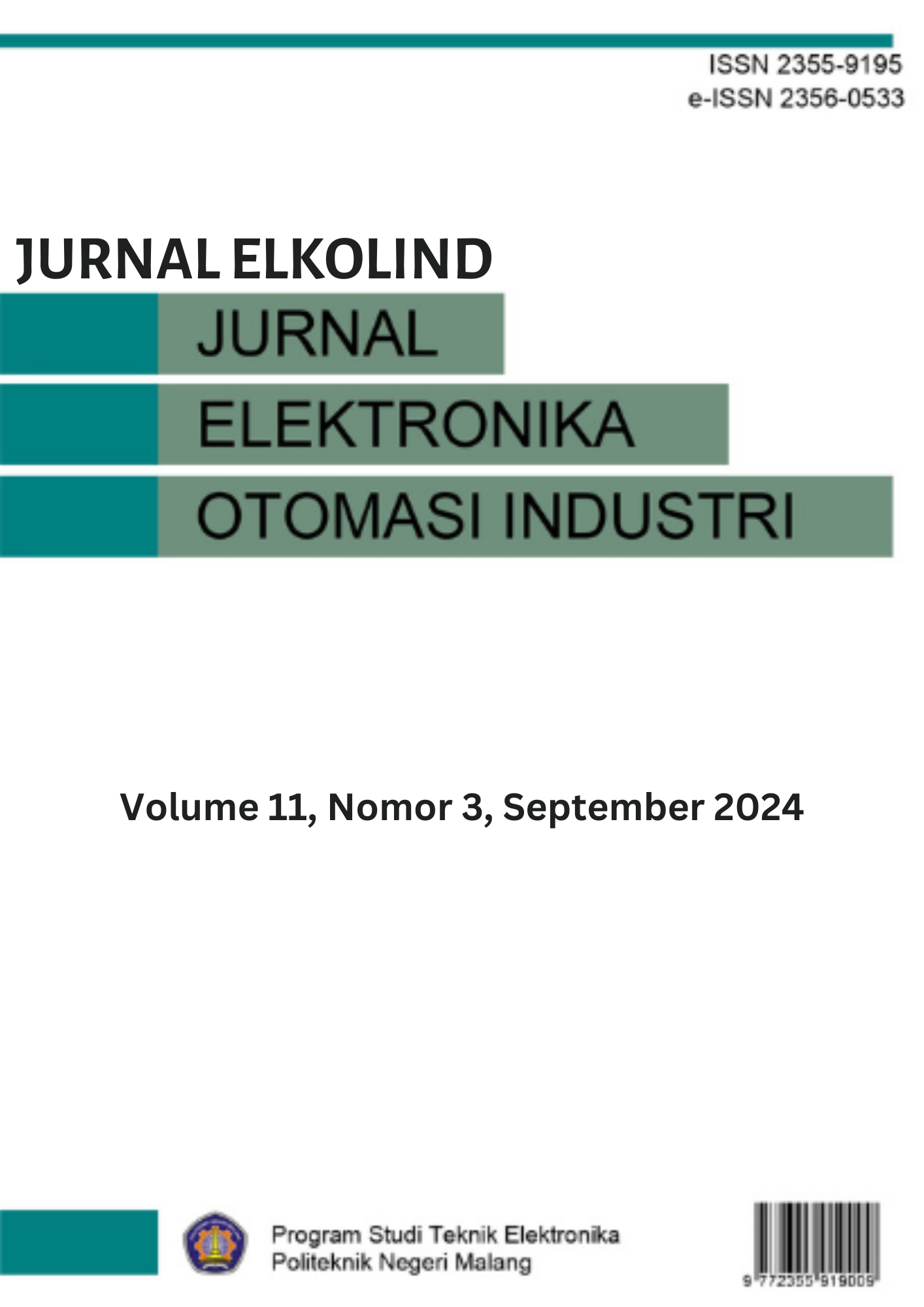Main Article Content
Abstract
Research in robotics, particularly mobile robots or wheeled mobile robots, continues to grow as their use in various sectors increases to simplify tasks and reduce the risk of human injury. Steering mechanisms, such as Swerve Drive, are becoming an important focus in the development of mobile robots. Swerve Drive enables omnidirectional motion that requires optimal control and complex development. Controlling the Swerve Drive requires large motors and sophisticated algorithms to set the speed and steering angle on each wheel independently, with the aim of achieving the targeted position and orientation. Simulation testing shows that the robot can move well using the prepared kinematics control, with translational, diagonal movement and rotational capabilities as required. Thus, kinematics modeling and development of efficient control algorithms are essential to improve the maneuverability and performance of the swerve drive robot.
Keywords
Article Details
Copyright (c) 2024 Mohammad Irfan Ilhan Shanjaya, Joko Endrasmono, Zindhu Maulana Ahmad Putra, Imam Sutrisno, Lilik Subiyanto, Ii Munadhif

This work is licensed under a Creative Commons Attribution 4.0 International License.
References
- B. B. I. Adinugraha, I. Siradjuddin, and L. Kamajaya, “Desain dan Kontrol Modular Independent Drive Independent Steering Mobile Robot Aktuator,” Metrotech (Journal of Mechanical and Electrical Technology), vol. 2, no. 3, pp. 144–150, Oct. 2023, doi: 10.33379/metrotech.v2i3.3349.
- M. Nurul Achmadiah, A. anwar Rosyidin, A. Pracoyo, I. Siradjuddin, D. A. Permatasari, and G. Al Azhar, “Desain permodelan dan simulasi Field Oriented Control (FOC) menggunakan motor BLDC,” Jurnal Elektronika dan Otomasi Industri, vol. 10, no. 3, pp. 361–368, Sep. 2023, doi: 10.33795/elkolind.v10i3.4416.
- M. Haniff, H. M. Saputra, E. A. Zaki Hamidi, C. H. A. H. B. Baskoro, and S. A. Pratama, “Design and Control of Swerve Drive Mechanism for Autonomous Mobile Robot,” in 2022 16th International Conference on Telecommunication Systems, Services, and Applications (TSSA), IEEE, Oct. 2022, pp. 1–6. doi: 10.1109/TSSA56819.2022.10063871.
- I. Siradjuddin, S. Wibowo, and A. A. Rofiq, “Pemodelan dan simulasi kinematika robot swerve 4 roda,” JURNAL ELTEK, vol. 20, no. 1, p. 42, Aug. 2022, doi: 10.33795/eltek.v20i1.301.
- B. Y. Suprapto, S. Dwijayanti, and D. Amri, “Development of a Position Control System for Wheeled Humanoid Robot Movement Using the Swerve Drive Method Based on Fuzzy Logic Type-2,” Elektronika ir Elektrotechnika, vol. 30, no. 1, pp. 4–13, Feb. 2024, doi: 10.5755/j02.eie.35912.
- Jeffrey Carothers, “Design of a Triple Singularity Drive for Mobile Wheeled Robots,” Massachusetts Institute of Technology, 2014.
- E. H. Binugroho, A. Setiawan, Y. Sadewa, P. H. Amrulloh, K. Paramasastra, and R. W. Sudibyo, “Position and Orientation Control of Three Wheels Swerve Drive Mobile Robot Platform,” in 2021 International Electronics Symposium (IES), IEEE, Sep. 2021, pp. 669–674. doi: 10.1109/IES53407.2021.9593947.
- Arif Rahman Hakim, Sumardi Sumardi, and Munawar Agus Riyadi, “KONTROL POSISI PADA SISTEM PERGERAKAN MOBILE ROBOT RODA MEKANUM MENGGUNAKAN KONTROL PID BERBASIS INVERS KINEMATIC,” Transient: Jurnal Ilmiah Teknik Elektro, vol. 4, pp. 463–470, Nov. 2015.
- M. J. C. Manullang, M. K. D. Hardhienata, and K. Priandana, “Kendali Robot Beroda Otonom dengan Inverse Kinematics,” Jurnal Ilmu Komputer dan Agri-Informatika, vol. 7, no. 1, pp. 62–73, May 2020, doi: 10.29244/jika.7.1.62-73.
- R. Ria, “Penerapan Inverse Kinematics pada Pengendalian Gerak Robot Lego,” Journal of Applied Electrical Engineering, vol. 2, no. 1, pp. 1–5, Dec. 2018, doi: 10.30871/jaee.v2i1.1075.
References
B. B. I. Adinugraha, I. Siradjuddin, and L. Kamajaya, “Desain dan Kontrol Modular Independent Drive Independent Steering Mobile Robot Aktuator,” Metrotech (Journal of Mechanical and Electrical Technology), vol. 2, no. 3, pp. 144–150, Oct. 2023, doi: 10.33379/metrotech.v2i3.3349.
M. Nurul Achmadiah, A. anwar Rosyidin, A. Pracoyo, I. Siradjuddin, D. A. Permatasari, and G. Al Azhar, “Desain permodelan dan simulasi Field Oriented Control (FOC) menggunakan motor BLDC,” Jurnal Elektronika dan Otomasi Industri, vol. 10, no. 3, pp. 361–368, Sep. 2023, doi: 10.33795/elkolind.v10i3.4416.
M. Haniff, H. M. Saputra, E. A. Zaki Hamidi, C. H. A. H. B. Baskoro, and S. A. Pratama, “Design and Control of Swerve Drive Mechanism for Autonomous Mobile Robot,” in 2022 16th International Conference on Telecommunication Systems, Services, and Applications (TSSA), IEEE, Oct. 2022, pp. 1–6. doi: 10.1109/TSSA56819.2022.10063871.
I. Siradjuddin, S. Wibowo, and A. A. Rofiq, “Pemodelan dan simulasi kinematika robot swerve 4 roda,” JURNAL ELTEK, vol. 20, no. 1, p. 42, Aug. 2022, doi: 10.33795/eltek.v20i1.301.
B. Y. Suprapto, S. Dwijayanti, and D. Amri, “Development of a Position Control System for Wheeled Humanoid Robot Movement Using the Swerve Drive Method Based on Fuzzy Logic Type-2,” Elektronika ir Elektrotechnika, vol. 30, no. 1, pp. 4–13, Feb. 2024, doi: 10.5755/j02.eie.35912.
Jeffrey Carothers, “Design of a Triple Singularity Drive for Mobile Wheeled Robots,” Massachusetts Institute of Technology, 2014.
E. H. Binugroho, A. Setiawan, Y. Sadewa, P. H. Amrulloh, K. Paramasastra, and R. W. Sudibyo, “Position and Orientation Control of Three Wheels Swerve Drive Mobile Robot Platform,” in 2021 International Electronics Symposium (IES), IEEE, Sep. 2021, pp. 669–674. doi: 10.1109/IES53407.2021.9593947.
Arif Rahman Hakim, Sumardi Sumardi, and Munawar Agus Riyadi, “KONTROL POSISI PADA SISTEM PERGERAKAN MOBILE ROBOT RODA MEKANUM MENGGUNAKAN KONTROL PID BERBASIS INVERS KINEMATIC,” Transient: Jurnal Ilmiah Teknik Elektro, vol. 4, pp. 463–470, Nov. 2015.
M. J. C. Manullang, M. K. D. Hardhienata, and K. Priandana, “Kendali Robot Beroda Otonom dengan Inverse Kinematics,” Jurnal Ilmu Komputer dan Agri-Informatika, vol. 7, no. 1, pp. 62–73, May 2020, doi: 10.29244/jika.7.1.62-73.
R. Ria, “Penerapan Inverse Kinematics pada Pengendalian Gerak Robot Lego,” Journal of Applied Electrical Engineering, vol. 2, no. 1, pp. 1–5, Dec. 2018, doi: 10.30871/jaee.v2i1.1075.
